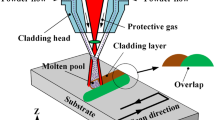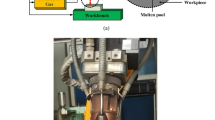Abstract
Nodular cast iron has the strength and toughness which are close to steel and is widely used in industrial fields. The repair and modification of nodular cast iron based on laser cladding can effectively improve the service life, corrosion resistance, and wear resistance of parts. However, nodular cast iron cladding is prone to cracks and hole defects, severely limiting the promotion and application of this technology. The evolution mechanism of multi-field coupling in the spheroidal graphite cast iron laser cladding is the key to quantitatively reveal the improvement of cladding quality. In this paper, moving Gaussian heat source, the influence of temperature change on material physical parameters, the Marangoni effect of molten pool surface tension, and buoyancy on the molten metal flow were considered. A multifield coupling three-dimensional numerical model of IN625 powder laser cladding on nodular cast iron by disk lasers was established. The calculation reveals the transient evolution law of the cladding temperature field, flow field, and plastic stress field. The microstructure morphologies of the cladding layer were observed by Zeiss sigma HD field emission SEM to verify the effectiveness of the model. The results show that the substrate heat input and heat loss reached equilibrium at 0.8s, and the highest temperature reached 1979.7K. There was apparent Marangoni flow in the molten pool, resulting in a small flow velocity in the center and large edges, and the maximum flow velocity was 0.203m/s. When the molten pool was air-cooled to ambient temperature in 1000s, the maximum residual stress was 429MPa. The micromorphology from the bottom to the top of the molten pool is planar crystals, cell crystals, columnar crystals, and equiaxed crystals, which are consistent with the numerical calculation results.





















Similar content being viewed by others
Data availability
The authors confirm that the data supporting the findings of this study are available within the article.
Change history
14 March 2022
Springer Nature’s version of this paper was updated to remove the blank page found in the PDF version and the placement of figures have been rearranged.
References
Takemoto Y, Mizumoto M, Kinno K (2020) Internal porosity defects in ductile cast irons. Int J Metalcast 1–14. https://doi.org/10.1007/s40962-020-00527-x
Endo M, Yanase K (2014) Effects of small defects, matrix structures and loading conditions on the fatigue strength of ductile cast irons. Theor Appl Fract Mec 69:34–43. https://doi.org/10.1016/j.tafmec.2013.12.005
Gu DD, Meiners W, Wissenbach K, Poprawe R (2013) Laser additive manufacturing of metallic components: materials, processes and mechanisms. Int Mater Rev 57(3):133–164. https://doi.org/10.1179/1743280411Y.0000000014
Lambarri J, Leunda J, Navas VG, Soriano C, Sanz C (2013) Microstructural and tensile characterization of Inconel 718 laser coatings for aeronautic components. Opt Laser Eng 51(7):813–821. https://doi.org/10.1016/j.optlaseng.2013.01.011
Gnanamuthu D S (1976) High temperature coatings by surface melting: US, 3952180
Zhao G, Cho C, Kim J-D (2003) Application of 3-D finite element method using Lagrangian formulation to dilution control in laser cladding process. Int J Mech Sci 45(5):777–796. https://doi.org/10.1016/S0020-7403(03)00140-1
Mirzade FK, Khomenko MD, Niziev VG (2016) Numerical simulation of solute evolution during laser cladding with nickel superalloy powder injection. Opt Quant Electron 48(11):513. https://doi.org/10.1007/s11082-016-0779-4
Cheng YH, Cui R, Wang HZ, Han ZT (2017) Effect of processing parameters of laser on microstructure and properties of cladding 42CrMo steel. Int J Adv Manuf Tech. https://doi.org/10.1007/s00170-017-0920-y
Li R, Qiu Y, Zheng Q, Liu B, Chen S, Tian Y (2018) Finite element simulation of temperature and stress field for laser cladded nickel-based amorphous composite coatings. Coatings 8(10). https://doi.org/10.3390/coatings8100336
Khamidullin B A, Tsivilskiy I V, Gorunov A I, Gilmutdinov A K (2019) Modeling of the effect of powder parameters on laser cladding using coaxial nozzle. Surf Coat Technol 364. https://doi.org/10.1016/j.surfcoat.2018.12.002
Luo K Y, Xu X, Zhao Z, Zhao S S, Cheng Z G, Lu J Z (2019) Microstructural evolution and characteristics of bonding zone in multilayer laser cladding of Fe-based coating. J Mater Process Technol 263:50-58https://doi.org/10.1016/j.jmatprotec.2018.08.005
Jg A, Cw A, Yh B, Xx A, Lg B (2020) Numerical simulation and experimental investigation on three-dimensional modelling of single-track geometry and temperature evolution by laser cladding. Opt Laser Technol 129. https://doi.org/10.1016/j.optlastec.2020.106287
He X, Fuerschbach PW, Debroy T (2003) Heat transfer and fluid flow during laser spot welding of 304 stainless steel. J Phys D Appl Phys 36(12):1388. https://doi.org/10.1088/0022-3727/36/12/306
Li C, Yu Z, Gao J, Zhao J, Han X (2018) Numerical simulation and experimental study of cladding Fe60 on an ASTM 1045 substrate by laser cladding. Surf Coat Technol 357:965–977. https://doi.org/10.1016/j.surfcoat.2018.10.099
Kubiak M, Piekarska W, Stano S (2015) Modelling of laser beam heat source based on experimental research of Yb:YAG laser power distribution. Int J Heat Mass Transf 83:679–689. https://doi.org/10.1016/j.ijheatmasstransfer.2014.12.052
Guo Q, Zhao C, Qu M, Xiong L, Hojjatzadeh SMH, Escano LI, Parab ND, Fezzaa K, Sun T, Chen L (2019) In-situ full-field mapping of melt flow dynamics in laser metal additive manufacturing. Addit Manuf 31. https://doi.org/10.1016/j.addma.2019.100939
Wirth F, Wegener K (2018) A physical modeling and predictive simulation of the laser cladding process. Addit Manuf 22:307–319. https://doi.org/10.1016/j.addma.2018.05.017
Zhang F, Zhang C, Chen SL, Zhu J, Cao WS, Kattner UR (2014) An understanding of high entropy alloys from phase diagram calculations. Calphad 45:1–10. https://doi.org/10.1016/j.calphad.2013.10.006
Zhang C, Miao J, Chen S, Zhang F, Luo A (2019) CALPHAD-based modeling and experimental validation of microstructural evolution and microsegregation in magnesium alloys during solidification. J Phase Equilib Diff 40(4):495–507. https://doi.org/10.1007/s11669-019-00732-0
Liu H, Li M, Qin X, Huang S, Hong F (2019) Numerical simulation and experimental analysis of wide-beam laser cladding. Int J Adv Manuf Technol. https://doi.org/10.1007/s00170-018-2740-0
Jiang Y, Cheng Y, Zhang X, Yang J, Yang X, Cheng Z (2019) Simulation and experimental investigations on the effect of Marangoni convection on thermal field during laser cladding process. Optik 203. https://doi.org/10.1016/j.ijleo.2019.164044
Song B, Yu T, Jiang X, Xi W (2019) Numerical model of transient convection pattern and forming mechanism of molten pool in laser cladding. Numer Heat Transf A Appl 75(12):855–873. https://doi.org/10.1080/10407782.2019.1608777
Wang ZJ, Dong SY, Xu BS, Xia W (2010) Effect of laser cladding processing parameters on metal forming efficiency and geometry. Infrared Laser Eng 39(02):315–319. https://doi.org/10.1155/2010/293410
Mingzhong HAO (2012) The optimization of laser cladding process parameters and adaptive finite element analysis. Dalian University of Technology, Dalian, pp 19–21
Tao YF, Jun LI, Ying-Hao L, Lie-Feng HU (2017) Residual stress distribution in different depths of TiNi/Ti_2Ni-based laser clad coating prepared at different environmental temperatures. Trans Nonferrous Met Soc 027(009):2043–2054
Gan Z, Gang Y, He X, Li S (2017) Numerical simulation of thermal behavior and multicomponent mass transfer in direct laser deposition of Co-base alloy on steel. Int J Heat Mass Trans 104(3):28–38. https://doi.org/10.1016/j.ijheatmasstransfer.2016.08.049
Funding
This work was supported by the Innovation Team Construction Project of University of Science and Technology Liaoning (601009830), Liaoning Provincial Natural Science Foundation (2019ZD0277), and University Innovation Talent Support Plan of Liaoning Province (20201020).
Author information
Authors and Affiliations
Contributions
Li Chang wrote the manuscript and is responsible for the experimental work. Xu Yan contributed to making the numerical simulation of the article. Jia Tenghui, Zhao Junjia, and Han Xing contributed to data extraction and format correction of the article. All the authors read and approved the final manuscript.
Corresponding author
Ethics declarations
Ethics approval
Not applicable.
Consent to participate
Not applicable.
Consent for publication
All authors consented to the publication.
Competing interests
The authors declare no competing interests.
Additional information
Publisher's Note
Springer Nature remains neutral with regard to jurisdictional claims in published maps and institutional affiliations.
Li Chang and Xu Yan are co-first authors of the article
Rights and permissions
About this article
Cite this article
Li, C., Xu, Y., Jia, T. et al. Numerical simulation research on multifield coupling evolution mechanism of IN625 laser cladding on nodular cast iron. Int J Adv Manuf Technol 119, 5647–5669 (2022). https://doi.org/10.1007/s00170-021-08249-y
Received:
Accepted:
Published:
Issue Date:
DOI: https://doi.org/10.1007/s00170-021-08249-y




